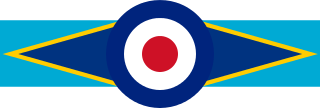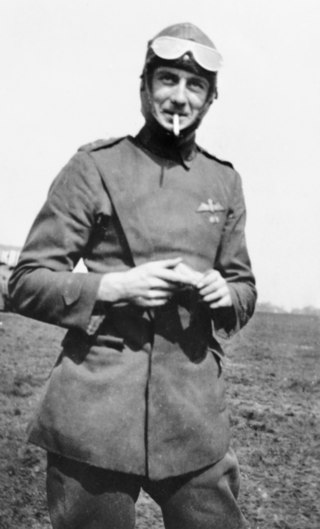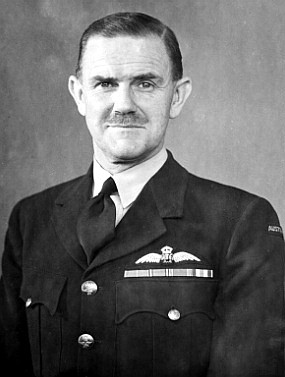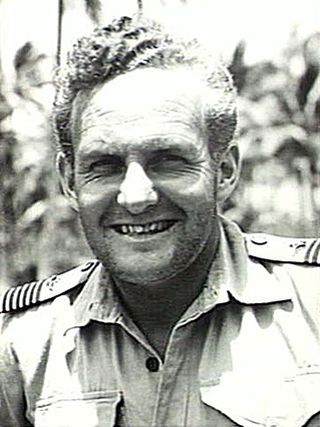
Jack Napier Davenport AC DSO DFC GM (9 June 1920 - 2 January 1996) was an Australian air force officer and business executive. [1] [2]

Jack Napier Davenport AC DSO DFC GM (9 June 1920 - 2 January 1996) was an Australian air force officer and business executive. [1] [2]
Davenport was born in the Sydney suburb of Rose Bay, New South Wales in 1920. [1] He attended North Bondi Public School and then Sydney Boys High School. [1] He commenced employment with the Commonwealth Bank as a clerk in 1936. [1]
After joining the Citizen Military Force, Davenport was posted to the 30th Battalion (New South Wales Scottish Regiment) in 1939. [1] At the outbreak of World War II, Davenport became a sergeant instructor for the Second Australian Imperial Force but later joined the Royal Australian Air Force in January 1941, qualifying as a pilot under the Empire Air Training Scheme. [1]
Commissioned in 1941 and promoted to flying officer in March 1942, Davenport joined the RAAF's No. 455 Squadron, flying Handley Page Hampden bombers in raids on Germany and carrying out anti-shipping strikes after the squadron transferred to RAF Coastal Command. [1]
Davenport was promoted to acting flight lieutenant in May 1942 and then to acting squadron leader in October 1942. [1]
In May 1943, Davenport received the Distinguished Flying Cross in recognition of his leadership and operational skills. [3] [1] He was later promoted to acting wing commander and appointed commanding officer of the squadron as they oversaw the conversion from Hampden bombers to Bristol Beaufighters. [1]
He was awarded the Distinguished Service Order in June 1944 and in September 1944, a medal bar was added to his Distinguished Flying Cross. [4] [1]
After risking his life to rescue one of his pilots from a crashed Beaufighter in September 1944, Davenport was awarded the George Medal in 1945. [5]
In October 1944, he was posted to No. 18 Group RAF headquarters in Dunfermline in Scotland to plan anti-shipping operations, after which he was ordered by Coastal Command to assess the effectiveness of its attacks in parts of Europe such as Norway. [1]
Davenport was promoted to Air-Commodore in January 1945. [6]
During his service overseas, Davenport married Sheila McDavid at St Cuthbert's Church in Saltcoats in Scotland on 8 January 1944. [1] Davenport returned to Sydney with his new wife and a baby son in March 1946. [1]
Davenport finished his service with the RAAF in May 1946. [1]
Following his service with the air force, Davenport was offered an executive position with Concrete Industries (Monier) Ltd. [1] He oversaw the company's successful expansion into overseas operations and served as managing director from 1970 to 1982. [1]
From the 1970s to the 1990s, Davenport served on numerous boards, councils and committees in various capacities. [1] These included the Royal Australian Air Force Association, Australian Gas Light Company, Reserve Bank of Australia, Australian War Memorial, Qantas, Mount Isa Mines, Dalgety & Co and the New South Wales Independent Commission Against Corruption. [7] [1]
For his service to business and industry, Davenport was made an Officer of the Order of Australia in the 1981 Queen's Birthday Honours. [8] Ten years later, he was promoted to a Companion of the Order of Australia in the 1991 Queen's Birthday Honours. [9]
In 1982, Davenport was awarded the Sir John Storey Medal from the Australian Institute of Management. [10]
Davenport also established a Charolais cattle stud on his property at Ebor. [10]
Davenport died in a Camperdown hospital late on 1 January 1996. [10] [1] However, his death is officially listed as 2 January 1996. [1]
There are two portraits Davenport housed in the Australian War Memorial in Canberra, by artists Dennis Adams and Harold Freeman. [11] [12]
In 2009, Kristen Alexander authored a biography entitled Jack Davenport: Beaufighter Leader. [13]

Air Commodore Arthur Henry Cobby, was an Australian military aviator. He was the leading fighter ace of the Australian Flying Corps during World War I, with 29 victories, despite seeing active service for less than a year.

On 9 February 1945, a force of Allied Bristol Beaufighter aircraft suffered many losses during an attack on the German destroyer Z33 and its escorting vessels; the operation was called Black Friday by the survivors. The German ships were sheltering in a strong defensive position in Førde Fjord, Norway, forcing the Allied aircraft to attack through massed anti-aircraft fire (FlaK).

No. 30 Squadron is a squadron of the Royal Australian Air Force (RAAF). Raised in 1942 as a long-range fighter unit, the squadron saw action in the Second World War, serving in the South West Pacific Area against the Japanese and operating mainly in the ground attack and anti-shipping roles from bases in New Guinea and the Netherlands East Indies. After the war, the squadron was disbanded, however, it was re-raised a short time later as a unit of the part-time Citizen Air Force, operating in the target towing and air defence role in New South Wales. In 1960s the squadron ceased flying aircraft and operated surface-to-air missiles, providing for the defence of Sydney and Darwin before disbanding in 1968. The squadron was re-raised again in 2010 and since then it has served as an airbase support squadron located at RAAF Base East Sale.

No. 22 Squadron is a Royal Australian Air Force (RAAF) mixed Permanent and Reserve squadron that provides support for the RAAF in the Sydney region. Formed in 1936, the squadron served in Papua New Guinea during the Second World War, and later followed the Pacific War as far as the Philippines. Following the war, the squadron was re-formed in 1948 but was converted to a non-flying support role in mid-1960. It is currently based at RAAF Base Richmond, New South Wales.

Royal Air Force Scorton or more simply RAF Scorton is a former Royal Air Force satellite station located next to the village of Scorton in North Yorkshire, England. The base was opened in October 1939 as part of 13 Group RAF Fighter Command and a satellite station of RAF Catterick. It was used by the Royal Air Force, the Royal Canadian Air Force, and the United States Army Air Forces Ninth Air Force during the war.

The name No. 68 Squadron has been used for two quite different units, only one of which was strictly a unit of the Royal Air Force. "No. 68 Squadron RFC" was for a time the official British military designation for No. 2 Squadron Australian Flying Corps.

No. 31 Squadron is a Royal Australian Air Force (RAAF) airbase support squadron. It was formed in August 1942 and disbanded in July 1946 after seeing action against the Japanese in the South West Pacific theatre of World War II. During the war, it operated the Bristol Beaufighter, which it operated in long-range fighter and ground-attack missions. The squadron was re-raised for its current role in July 2010.

Wilfred Stanley Arthur, was a fighter ace and senior officer of the Royal Australian Air Force (RAAF) during World War II. Commonly known as "Woof", and sometimes "Wolf" or "Wulf", he was officially credited with ten aerial victories. As a commander, he led combat formations at squadron and wing level, becoming at 24 the youngest group captain in the history of the RAAF.

Air Marshal Sir John Patrick Joseph McCauley, KBE, CB was a senior commander in the Royal Australian Air Force (RAAF). He served as Chief of the Air Staff from 1954 to 1957. A Duntroon graduate, McCauley spent four years in the Australian Military Forces before transferring to the RAAF in 1924. He was Director of Training from 1936 to 1938, and commanded engineering and flying training schools for the first eighteen months of World War II. Having been promoted to group captain in 1940, he was posted to Singapore in June 1941 to take charge of all RAAF units defending the area. He earned praise for his efforts in attacking invading Japanese forces before the fall of Singapore, and for his dedication in evacuating his men. After serving as Deputy Chief of the Air Staff in 1942–44, he was appointed to a senior operational role with the Royal Air Force's 2nd Tactical Air Force in Europe, where he saw out the rest of the war.

Air Marshal Sir Charles Frederick Read, KBE, CB, DFC, AFC was a senior commander in the Royal Australian Air Force (RAAF). He served as Chief of the Air Staff (CAS) from 1972 to 1975. Born in Sydney, Read joined the RAAF in 1937, and began his career flying biplane fighters. As a Beaufighter pilot, he led No. 31 Squadron and No. 77 Wing in the South West Pacific during World War II. His achievements earned him the Distinguished Flying Cross and a mention in despatches, and he finished the war an acting group captain.
Adrian Philip "Tim" Goldsmith, was an Australian flying ace of the Second World War. Officially credited with shooting down 16¼ enemy aircraft while serving with the Royal Australian Air Force, Goldsmith scored 12¼ of his victories during the Siege of Malta. His final four victories were achieved against Japanese aircraft while conducting operations over the South West Pacific.
Russell George Foskett, was an Australian aviator and flying ace of the Second World War. Born in a suburb of Sydney, Foskett was employed as a clerk in 1940 when he enlisted in the Royal Australian Air Force. Accepted as a pilot under the Empire Air Training Scheme, he completed his training in Australia and Southern Rhodesia, before transferring for service over North Africa. In subsequent aerial engagements, Foskett was officially credited with the destruction of 61⁄2 Axis aircraft and awarded the Distinguished Flying Cross. Appointed to command No. 94 Squadron RAF, he was transferred to the Mediterranean Theatre in 1944. Foskett was killed on 31 October 1944, after his aircraft developed engine trouble and he was forced to bail out over the Aegean Sea, where his parachute failed to open.

Air Vice Marshal Adrian Lindley Trevor Cole, CBE, DSO, MC, DFC was a senior commander in the Royal Australian Air Force (RAAF). Joining the army at the outbreak of World War I, he transferred to the Australian Flying Corps in 1916 and flew with No. 1 Squadron in the Middle East and No. 2 Squadron on the Western Front. He became an ace, credited with victories over ten enemy aircraft, and earned the Military Cross and the Distinguished Flying Cross. In 1921, he was a founding member of the RAAF.

Air Vice Marshal Francis Masson (Frank) Bladin, was a senior commander in the Royal Australian Air Force (RAAF). Born in rural Victoria, he graduated from the Royal Military College, Duntroon, in 1920. Bladin transferred from the Army to the Air Force in 1923, and learned to fly at RAAF Point Cook, Victoria. He held training appointments before taking command of No. 1 Squadron in 1934. Quiet but authoritative, he was nicknamed "Dad" in tribute to the concern he displayed for the welfare of his personnel.

John Lloyd Waddy, was a senior officer and aviator in the Royal Australian Air Force (RAAF), and later served as a member of the New South Wales Legislative Assembly and Minister of the Crown. As a fighter pilot during World War II, he shot down 15 enemy aircraft during the North African campaign, becoming one of Australia's top-scoring aces and earning the Distinguished Flying Cross. Waddy went on to command No. 80 Squadron in the South West Pacific, where he was awarded the US Air Medal. He was one of eight senior pilots who took part in the "Morotai Mutiny" of April 1945.
Charles Arbuthnot Crombie was an Australian aviator and flying ace of the Second World War. Born in Brisbane, he was working as a jackeroo when he enlisted in the Royal Australian Air Force in May 1940. Completing flight training in Australia and Canada, he flew in the European, Mediterranean and Middle East Theatre and South-East Asian theatres, amassing a tally of 12 Axis aircraft shot down, with an additional four probables. In a particular attack on 19 January 1943, Crombie intercepted a formation of four Japanese bombers over India. Despite his aircraft being set alight early in the engagement, he shot down two of the bombers and severely damaged a third before he was forced to bail out. He was awarded the Distinguished Service Order for this action. Returning to Australia late in 1943, he was promoted to squadron leader and posted as a flight instructor with No. 5 Operational Training Unit. Crombie was killed in a flying accident in August 1945.

Charles Eaton, OBE, AFC was a senior officer and aviator in the Royal Australian Air Force (RAAF), and later served as a diplomat. Born in London, he joined the British Army upon the outbreak of World War I and saw action on the Western Front before transferring to the Royal Flying Corps in 1917. Posted as a bomber pilot to No. 206 Squadron, he was twice captured by German forces, and twice escaped. Eaton left the military in 1920 and worked in India until moving to Australia in 1923. Two years later he joined the RAAF, serving initially as an instructor at No. 1 Flying Training School. Between 1929 and 1931, he was chosen to lead three expeditions to search for lost aircraft in Central Australia, gaining national attention and earning the Air Force Cross for his "zeal and devotion to duty".

No. 77 Wing was a Royal Australian Air Force (RAAF) wing of World War II. It formed part of No. 10 Operational Group at its establishment in November 1943, when it comprised three squadrons equipped with Vultee Vengeance dive bombers. No. 77 Wing commenced operations in early 1944, flying out of Nadzab, Papua New Guinea. Soon afterwards, however, the Vengeance units were withdrawn from combat and replaced with squadrons flying Douglas Bostons, Bristol Beaufighters and Bristol Beauforts. The wing saw action in the assaults on Noemfoor, Tarakan, and North Borneo, by which time it was an all-Beaufighter formation made up of Nos. 22, 30 and 31 Squadrons. It was to have taken part in the Battle of Balikpapan in June 1945, but unsuitable landing grounds meant that the Beaufighter units were withdrawn to Morotai, sitting out the remainder of the war before returning to Australia, where they disbanded, along with the wing headquarters, in 1946.

No. 79 Wing was a Royal Australian Air Force (RAAF) wing of World War II. It was formed in December 1943 at Batchelor, Northern Territory, as part of North-Western Area Command. Led by Group Captain Charles Eaton, the wing comprised four squadrons on its establishment, flying Beaufort and B-25 Mitchell bombers and Beaufighter heavy fighters. No. 79 Wing took part in the New Guinea and North-Western Area Campaigns during 1944–45, eventually transferring to Balikpapan in the Dutch East Indies as the Allies advanced northward. By the end of the Pacific War, the wing was attached to the Australian First Tactical Air Force and was made up of Nos. 2 and 18 Squadrons, both flying Mitchells. The latter transferred to the Netherlands Air Force in late 1945, while the former returned to Australia where it disbanded the following year. No. 79 Headquarters itself disbanded in October 1945, soon after the end of hostilities.

John Raeburn Balmer, was a senior officer and bomber pilot in the Royal Australian Air Force (RAAF). Born in Bendigo, Victoria, he studied law before joining the RAAF as an air cadet in 1932. An instructor at Point Cook from 1935 to 1937, he achieved renown in Air Force circles when he reportedly parachuted from a training aircraft to motivate his pupil to land single-handedly. He also became known to the general public as a cross-country motorist, setting records for trans-Australia and round-Australia trips before World War II.